Recommended sightseeing spots all over Japan!
Tohoku area
- Nocturne
Hirosaki Park and Hirosaki Castle [Hirosaki City, Aomori Prefecture] -
Access: Nocturne, get off at Hirosaki Bus Terminal, about 25 minutes on foot or about 15 minutes by car
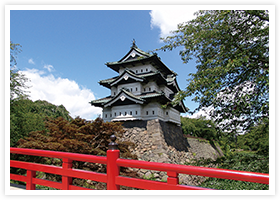
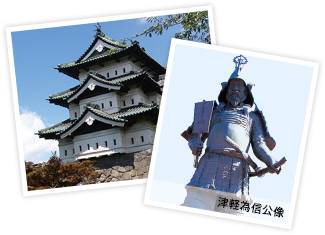
"The town of castles, cherry blossoms, and apples" - the symbol of Hirosaki City
Hirosaki Park (also known as Takaage Park or Takaageen) is based on Hirosaki Castle, which was the residence of the Tsugaru family that ruled the Hirosaki domain during the feudal period. Located in the center of Hirosaki City, the park covers an area of approximately 492,000 square meters, and there are many remains of the castle tower, turrets, castle gates, and other structures that still remain today.
Hirosaki Castle, also known as Takaoka Castle (Takaoka Castle), was the residence of the Tsugaru family that ruled the Hirosaki domain during the feudal period. Construction of the castle began in Takaoka in 1603 by Tsugaru Tamenobu, who unified the Tsugaru region. it was done. Construction of the castle was halted due to Tamenobu's death, but the second lord of the domain, Nobuhira, resumed construction, and the castle was completed in 1611 (1611) and renamed Hirosaki Castle in 1628 (5th year of Kan'ei).
Japan's most popular cherry blossom festival is held in the spring, the autumn leaves festival is held in the fall, and the snow lantern festival is held in the winter, where many giant snow statues and mini kamakura are made.In addition to the Neputa festival that runs through the city in the summer, You can enjoy events throughout the four seasons. Hirosaki Castle, which attracts many tourists every year, celebrated its 400th anniversary in 2011.

- Beam No. 1
Ryusendo Cave [Shimohei District, Iwate Prefecture] -
Access: Beam No. 1, get off at Miyako Station → about 2 hours by train → get off at Iwaizumi Station → about 15 minutes by bus
Mysteries of nature and a fantastic world
Ryusendo Cave is considered one of Japan's three major limestone caves and is also designated as a national natural monument. The inside of the cave is over 3,100 meters long, and the total length is estimated to be over 5,000 meters, with numerous stalactites and other sources of gushing water forming deep underground lakes in several places. The lake water inside the cave, which is full of amazing natural mysteries, creates a fantastical world, and the fourth underground lake (not open to the public) is the deepest in Japan at 120 meters, and boasts one of the clearest waters in the world. Ryusen Shindo Cave, located opposite the entrance to Ryusendo Cave, is open to the public as the world's first natural cave science museum.
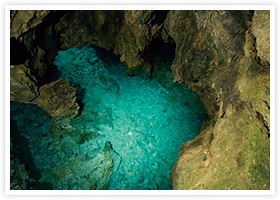
- Beam No. 1
Koiwai Farm [Iwate District, Iwate Prefecture] -
Access: Beam No. 1, get off at Morioka Minami → about 20 minutes by bus → about 30 minutes by bus from Morioka Station
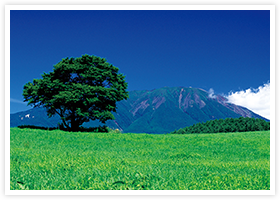
A historic farm loved by Kenji Miyazawa
It is known as a representative tourist destination in Iwate Prefecture, and facilities such as ``Koiwai Farm Makibaen'' are open to the public. The Iwate Snow Festival, which boasts a history of over 40 years, is held every year in early February, and the Toro Horse Carriage Railway also operates for sightseeing, allowing you to enjoy various tours and events throughout the year. In addition, there are nine buildings on the grounds that have been designated as cultural properties, all of which were built from the late Meiji period to the early Showa period, and more than half of them are still in use. It is also famous for the lone cherry tree standing against Mt. Iwate, and you can enjoy the magnificent scenery regardless of the season.

- Beam No. 1
Morioka Castle Morioka Castle Ruins Park (Iwate Park) [Morioka City, Iwate Prefecture] -
Access: Beam No. 1, get off at Morioka Minami → about 20 minutes by bus → about 15 minutes on foot from Morioka Station
made of stone wallOne of the three major castles in Tohoku
The ruins of Morioka Castle, which was the residence of the lord of the Southern (Morioka) domain, and was once called Kozukata Castle, are now familiar to citizens as Iwate Park. Morioka Castle, which is characterized by its all-stone walls made of abundant white granite, was built in 1597 by Nobunao Nanbu, the first lord of the Morioka domain, with his son Toshinao as general magistrate, and 36 years later, the third lord of the domain, Nanbu Shigenao enters the castle. After Nobunao's death, Toshinao, who took over as head of the family, went to Yamagata in the Battle of Sekigahara, participated in the Osaka Winter Siege, and worked to strengthen relations with the Edo Shogunate. Morioka's specialty, ``Wanko Soba,'' is said to have come to be called ``Wanko Soba'' because when Toshinao stopped by Hanamaki Castle on his way to Edo, he refilled many bowls of delicious soba noodles.
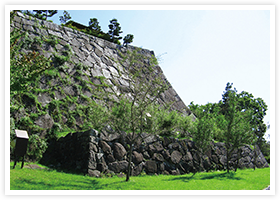
Toward China
- camel
Tottori Sand Dunes [Tottori City, Tottori Prefecture] -
Access: Camel-go, get off at Tottori Station → about 20 minutes by bus
Overwhelming scale and beauty
The Tottori Sand Dunes, one of Japan's three major sand dunes, are designated as a special protection area of San'in Kaigan National Park, and are the largest tourist sand dunes in Japan, stretching 2.4 km from north to south and 16 km from east to west on the Sea of Japan coast. It was designated as a national natural monument in 1955, and was selected as one of Japan's top 100 geological sites in 2007. Early in the morning, the wind ripples spread across the sand dunes, where there are no footprints yet, and you will be overwhelmed by their majestic scale and artistic beauty. The sunset over the Sea of Japan is also spectacular, and the changing colors of the sky and sea as time passes are spectacular. At Tottori Sand Dunes, in addition to sightseeing tours such as camel tours and horse-drawn carriage tours, you can also enjoy sports such as paragliding and sandboarding using the undulating slopes.
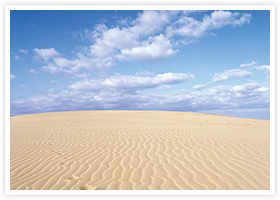
- camel
Tottori Castle [Tottori City, Tottori Prefecture] -
Access: Camel-go, get off at Tottori Station → about 10 minutes by bus
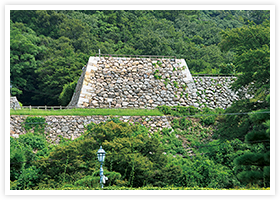
The stage of the clash between the Oda army and the Mori army: Hideyoshi Hashiba’s thirsty murder of Tottori
Tottori Castle, also known as Hisamatsuyama Castle, was established as a medieval castle and is famous for being the stage of the battle between Oda Nobunaga's vassal Hideyoshi Hashiba and the Mori army during the Sengoku period (attacking China and raiding Tottori Castle for supplies). In 1580, Yamana Toyokuni, the feudal lord of Inaba Province, surrendered to Nobunaga during Hideyoshi's first siege of Tottori Castle on Nobunaga's orders. However, they surrendered to the Mori army that attacked at the same time. The vassals of Tottori Castle, who claimed to be subordinate to the Mori family, expelled Toyokuni, who was a vassal to Nobunaga. The Mori clan welcomes a new castle lord, Tsuneie Kikkawa. The following year, in 1581, Hideyoshi invaded Inaba Province and set up his headquarters on Mt. Taishaku (present-day Taikogahara, Honjinyama). This marks the start of the second siege of Tottori Castle, which is also known as the ``Killing''. In preparation for this attack, Hideyoshi bought up all the rice at a high price in advance, and thoroughly blocked the Mori forces from bringing in supplies. As a result of this strategy, the castle's food supply ran out in the blink of an eye, and people began to starve to death. Despite this, Tsuneie persevered through the siege, but finally surrendered. Hideyoshi tried to force Tsuneie to submit to the Oda family, but Tsuneie was determined to commit suicide and spared the lives of the castle soldiers in exchange for his own seppuku, and Tottori Castle surrendered and surrendered.

- camel
Yonago Castle Ruins [Yonago City, Tottori Prefecture] -
Access: Camel train, get off at Yonago Station → 15 minutes walk
One of the most famous castles in the San'in region with large and small castle towers
Yonago Castle, built on Mt. Minato at an altitude of 90 meters in the center of Yonago City, is a full-fledged early modern castle that was built ahead of other castles in the San'in region. Also known as ``Kume Castle'' or ``Minatoyama Castle,'' it is said to have been built as a fort in Iiyama by Muneyuki Yamana during the Onin to Bunmei era (1467-1487). In the early Edo period, it was also the domain office of the Yonago domain (Hoki domain). The full-fledged castle on Mt. Minato, now called "Shiroyama," was built in 1591 by Hiroie Kikkawa, a military commander from the Azuchi-Momoyama and early Edo period who became the lord of Nishi-Hoki. Start building a castle. However, Hiroie, a vassal of the Mori clan, was defeated in the Battle of Sekigahara in 1600, and the Yoshikawa clan moved to Iwakuni. After that, Kazutada Nakamura became the lord of Hoki Province, and Yonago Castle is said to have been completed around 1602. However, in 1609, when Kazutada suddenly died and the Nakamura clan became extinct, Sadayasu Kato entered the castle as the lord of Kanai and Kaniri, and Omi saint Nakae Toki also came to Yonago. In 1632, Narutoshi Arao, chief retainer of the Tottori domain, became the lord of Yonago Castle, and the Arao family ruled the castle for 11 generations. In 1869, Yonago Castle was sold to the samurai clan and all buildings were demolished. Although all the buildings from that time have been lost, the stone walls and foundation stones have preserved the form of the castle well, and many documents and pictorial materials have been passed down in good condition. It has been designated as a historic site. Nearby is the Yonago City San'in History Museum, which contains historical materials related to Yonago Castle, such as the four-tiered Shachi turret and a model of the Yonago Castle tower, as well as archaeological materials excavated from the city, folklore materials, and other materials that tell the history of Yonago. Materials are on display. Currently, the area around Minatoyama is used as Minatoyama Park as a place for citizens to relax, and the view from the castle tower that offers a panoramic view of Nishihoki is loved by many people.
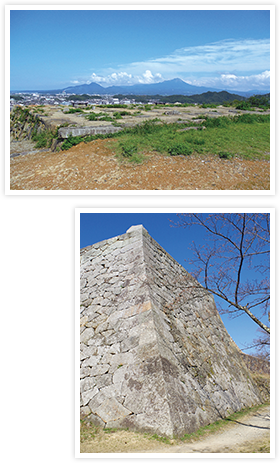
Shikoku area
- Eddie
Naruto Strait -
Access: Eddy train, get off at Expressway Naruto → about 25 minutes by bus
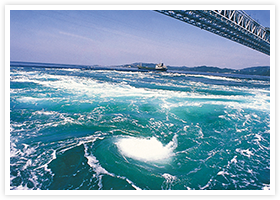
The fastest whirlpool in Japan and the world's largest
The Naruto Strait is a very popular tourist attraction, with beautiful scenery that has been selected as one of Japan's 100 Scenic Spots, and where one of the world's largest whirlpools occurs. The Naruto Strait, which connects the Harima Sea and the Kii Channel, has a unique topography and has opposite low and high tide times, creating violent currents and spectacular whirlpools that are the fastest in Japan and one of the world's top three currents. There are many facilities in Naruto City where you can observe the powerful whirlpools, but among them is the 450m-long Onaruto Bridge promenade, ``Uzu no Michi'', where you can see the world's largest whirlpools at a height of 45m above sea level. You can observe it from below (charges apply). You can also enjoy Awa Odori as a seasonal event.

- Eddie
Bizan (Bizan Park) [Tokushima City, Tokushima Prefecture] -
Access: Eddy train, get off at Tokushima Station → about 10 minutes walk → about 6 minutes by ropeway
The symbol of Tokushima City at an altitude of 290m
Mount Bizan, which is said to be ``Mount Awa that can be seen in the clouds like the eyebrows'' in the Manyoshu, is so called because it looks like an ``eyebrow'' when viewed from any direction, and is the symbol of Tokushima City. It has also become. The area around the summit is Bizan Park, which includes a memorial tower, a pagoda, Moraes Hall, and an observation rest facility. The view from the top of the mountain is spectacular, and you can see not only Tokushima city but also Awaji Island and the Kii Peninsula on clear days, and the beautiful night view is also worth seeing. In addition, the changing seasons, such as the cherry blossoms in spring and the colored leaves in autumn, are beautiful and delight visitors. We recommend using the ropeway to access the mountaintop. Enjoy a walk in the air with a wonderful view. The Awa Odori Hall, which also serves as the base station of the Bizan Ropeway, introduces the history and charm of Awa Odori.
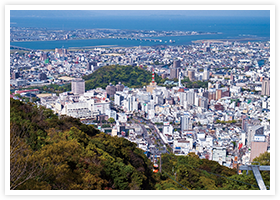
- Eddie
Tokushima Castle Tokushima Central Park (Tokushima Castle Ruins) [Tokushima City, Tokushima Prefecture] -
Access: Eddy train, get off at Tokushima Station → 10 minutes walk
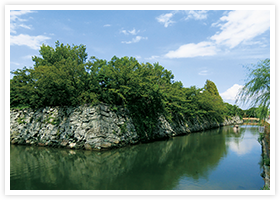
A famous castle built by Iemasa Hachisuka with Awa blue stone.
In 1585, thanks to Toyotomi Hideyoshi's efforts to conquer Shikoku, Hachisuka Iemasa was given the province of Awa, and built a large-scale Hirayama Castle on its current location, and Tokushima Castle was completed the following year. According to one theory, Awa Odori is said to have originated when the family administration served sake to the castle town to celebrate the completion of the castle, and the townspeople danced wildly. Iemasa Hachisuka was a military commander in the Azuchi-Momoyama/early Edo period and the founder of the Awa (Tokushima) domain. He served Oda Nobunaga and then Toyotomi Hideyoshi, and served with his father Masakatsu as a member of the Yellow Mothers group when Hideyoshi attacked Mori in China on Nobunaga's orders. In 1582, when Nobunaga was defeated by Akechi Mitsuhide at Honnoji, he followed Hideyoshi and participated in the Battle of Yamazaki. Although he belonged to the Western army at the Battle of Sekigahara, he did not take part himself and sent his eldest son Shichin to join the Eastern army. Tokushima Castle was ruled by the Hachisuka family until the abolition of the feudal domain and establishment of prefectures, but in the Meiji era, the building was demolished and only the Eagle Gate remained, but unfortunately it was destroyed by fire in the Great Tokushima Air Raid in 1945. I did. On January 26, 2006, the Tokushima Castle ruins were designated as a national historic site, and are now maintained as a castle ruins park along with the Tokushima Castle Museum. It is familiar to citizens as both a familiar recreation area and a symbolic presence.

Long distance bus page for each route
- Toward China